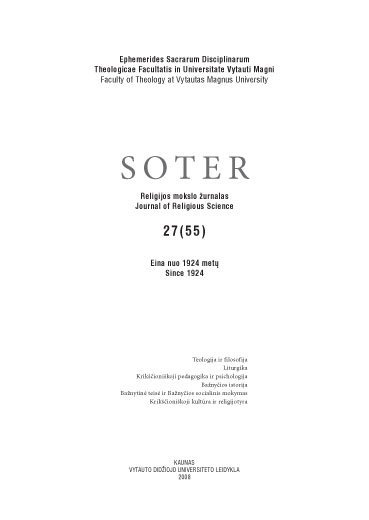Dievo tarnaitės Barboros Žagarietės Umiastauskaitės šventumo fenomenas (II)
THE PHENOMENON OF SANCTITY OF BARBORA ŽAGARIETĖ (UMIASTAUSKAITĖ)
Author(s): Rasa Račiūnaitė-PaužuolienėSubject(s): Christian Theology and Religion
Published by: Vytauto Didžiojo Universitetas
Keywords: Barbora Žagarietė (Umiastauskaitė); šventumas; stebuklai; Barbora Žagarietė (Umiastauskaitė); the phenomenon of sanctity; miracles.
Summary/Abstract: The article analyzes the holy phenomenon of the seventeenth century martyr to chastity Barbora Žagarietė (Umiastauskaitė). This work is based on the previous sources and field investigation materials gathered by a group of scientists in 2006 in the districts of Šiauliai, Joniškis (Lithuania) and Dobele (Latvia). The author presents the latest scholarly research on phenomenon of Barbora Žagarietė, weaving together findings from field research in 2006 and interviews with respondents. The oldest sources proclaim the miracles that were received through the intercession of Barbora Žagarietė since the XVIII century. The efforts through the centuries to legalize the cult of Barbora Žagarietė as a saint by the common people were not successful. Due to the long occupation of Lithuania the process of canonization is longstanding. National veneration of Barbora continues up to the present. Barbora Žagarietė (Umiastauskaitė), representing the Catholic culture of North Samogitia, is the so-called “Saint of Žagarė”, “the second Blessed Virgin Mary”, “an invisible sister who is appreciable”, as well as patroness, the witness of real Christian faith, guru of life, and mediatrix between God and people. In short, the cult of the Servant of God Barbora Žagarietė shapes the cultural and religious identity of the local people. Some factors testify to the sanctity of Barbora Žagarietė (Umiastauskaitė): 1) her virtues of piety, mercy and purity; 2) her non-decaying body, which was certified by physical examination in 1963; 3) the oldest sources contain notations on the miracles obtained by the intercession of Barbora Žagarietė; 4) the blessings of Barbora Žagarietė, from which people obtain graces and recovery from illness today; 5) the cult of the Servant of God Barbora Žagarietė is spread by the common people. The author also discusses the issue of terminology, relevant both to the religious stories and to the legends. The distinctive features of the religious stories are discussed in more detail. Religious stories could be evaluated as historical religious documents reflecting the folk world outlook. Contemporary religious stories express the intimate relationship between the respondents and Barbora Žagarietė, reflecting, interpreting and evaluating an individual religious experience and individual religious sensibility. Religious stories testify to nation-wide veneration of the Servant of God Barbora’s up to the present. The following popular groups of religious stories could be discerned from the field research material gathered by the group of scientists in 2006 in the districts of Šiauliai, Joniškis (Lithuania) and Dobele (Latvia): 6) narratives of Barbora’s biography; 7) narratives about miraculous powers of Barbora’s body; 8) religious stories about the miracles that were obtained by the intercession of Barbora; 9) narratives about the profanation of Barbora’s remains; 10) narratives about the disappearance of Barbora’s body;
Journal: SOTER: religijos mokslo žurnalas
- Issue Year: 55/2008
- Issue No: 27
- Page Range: 143-164
- Page Count: 22
- Language: Lithuanian

